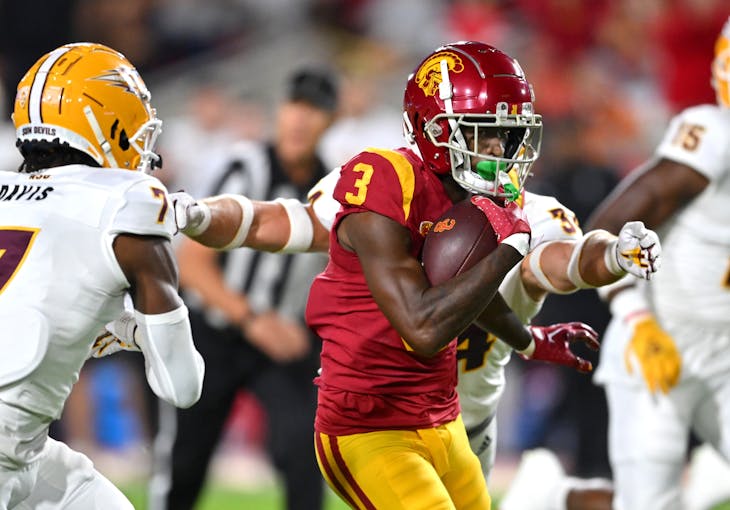
Look for May's Dynasty Trade Value Chart article analyzing how the draft impacted veterans tomorrow. Today’s Dynasty Trade Value Chart is focused solely on rookies and how to value this class as we head into rookie drafts. We will update the value of rookie players and explain how we arrived at those values. However, the real goal here is to give you an analytical framework to help you create your own rookie values and rankings. We have created a Google Sheet with base values determined by position-adjusted draft capital and encourage you to make a copy of it, make your own adjustments, and use the values you come up with to help you navigate through your upcoming rookie drafts:
Rookie Pick Worksheet (File>Make a Copy will allow you to edit the values).
Before we give our own valuations and reasoning and break things down into tiers (with a focus on Superflex drafts), let’s first give a quick overview of the process we recommend you employ to reach the best possible rookie valuations based on your own prospect evaluations.
Draft Capital
Our method leans heavily on draft capital as the starting point for any rookie valuation. We start with a model-based approach that looks back at the past decade of drafts and how much each player drafted actually ended up being worth to come up with base values for players based solely on their position and where they were drafted. For example, knowing nothing other than the fact that a running back was drafted 8th overall, our model would value that player at 45. The belief here is that the NFL decision-makers have more information, more on the line, and more experience evaluating prospects than we do. They are good enough at their jobs to at least give us a very strong starting point for our own valuation process.
In the Google Sheet linked above, these model-based starting values can be found in the columns “Draft Cap. PPR” for normal one quarterback leagues and “Draft Cap. SF” for Superflex leagues.
Making Adjustments
While there is a belief in using draft capital as a starting point, there is still a lot of room to improve on these naive player valuations by applying our own knowledge of the players skills, the situation they are drafted into, and our own level of personal belief in the prospect.
1. Skillset Adjustment
The "Skillset" column you will see in the Google Sheet allows you to adjust for how fantasy-friendly a player’s skills are. The most obvious adjustments here will be for the following player characteristics:
A. Quarterback rushing ability
Lamar Jackson was a late-first-round pick, but even at the time of the draft, we valued him more highly than his draft capital would have suggested because his special running ability gave him a ton of fantasy upside. Justin Fields is another recent example. In this class, we are going to give Anthony Richardson a solid bump based on how much fantasy rushing upside he brings to the table.
B. Tight ends who excel as pass catchers
We give “Move TEs” a positive adjustment. For fantasy purposes, we only care how much offensive production we get from our tight ends. There are no fantasy points for good blocking. We are clearly evaluating on a different scale than NFL evaluators, so it makes sense for us to make some common sense adjustments to the initial draft capital-based valuations based on whether the player’s skillset is fantasy friendly or not. Dalton Kincaid is basically a big slot receiver, we are going to give him a positive boost based on his skill set.
C. Potential high-volume PPR targets
A player with field-stretching speed impacts the NFL game in ways that are not reflected in fantasy points, and those guys are drafted higher as a result. On the other hand, potential high-volume slot targets who are not speedsters (think Cooper Kupp, Keenan Allen, Amon-Ra St. Brown, Jaxon Smith-Njigba, etc.) often have more fantasy upside than their draft capital would suggest. We give these guys a boost in our rankings.
2. Situational Adjustments
We do not want to go too overboard here, but situation does matter. Imagine a universe where the Bengals traded up to #52, drafted Zach Charbonnet, and promptly cut Joe Mixon. Clearly, Charbonnet would be worth more in that hypothetical than he is now based on being drafted to back up and complement Ken Walker III. We have to deduct some value points from Charbonnet based on being drafted into a situation that limits his realistic fantasy upside.
3. Other
We have one last column for any final adjustments that don’t fit neatly into either the skillset or situation buckets. Is your favorite draft analyst especially high on a player? Give him a 10% boost or whatever you feel comfortable with. We all have our guys, and there is nothing wrong with putting your finger on the scales a little bit to move a guy up some. There is value in doing so in a more calculated manner and not getting too far out over your skis in terms of making wild adjustments, however. Personally, I try to keep adjustments in this category under 20%, especially in the early rounds of rookie drafts. In the later rounds, it makes sense to adjust more aggressively.
Tier 1
Continue reading this content with a ELITE subscription.
An ELITE subscription is required to access content for Dynasty leagues. If this league is not a Dynasty league, you can edit your leagues here.
